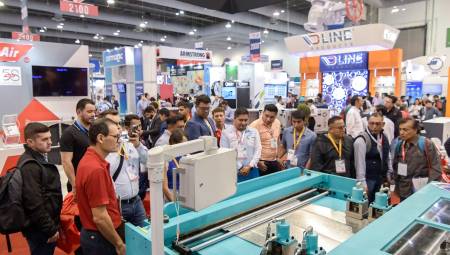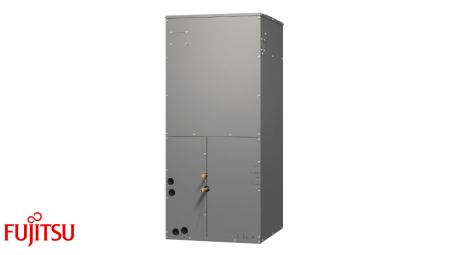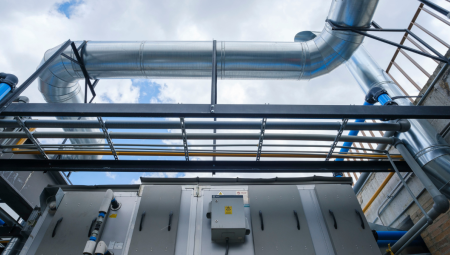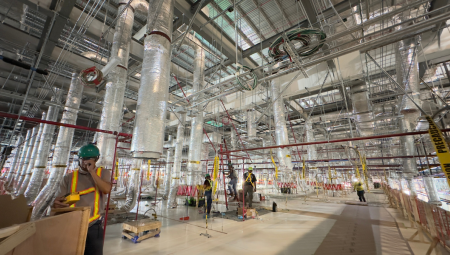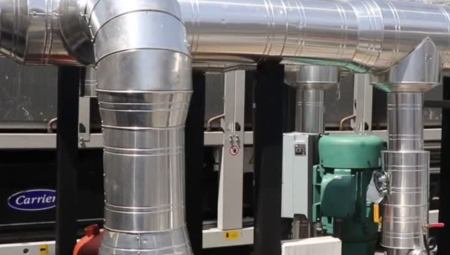In buildings with air conditioning and air conditioning systems, more than 80% of the energy used is destined to this equipment, and of this, most corresponds to the operation of compressors. For this and other reasons, scroll technology is presented as a high-performance and precision option.
The concept of the scroll compressor has been around for over a hundred years. Even so, the development of this technology in its modern stage began in the 70s. The introduction of numerically controlled machines provided the basis for the precise machining of the elements necessary for a scroll compressor to operate quietly and efficiently. Currently, this technology is widely used in air conditioning and refrigeration applications, covering a wide range of operation using various refrigerants, being more common the one ranging from 1 to 25 tons.
Since their introduction to the unit air conditioning market in the late 80s, scroll compressors have been very successful in both residential and commercial applications, being the smallest (1 to 6 tons) more common in residential systems, such as thermal pump systems used to heat or cool homes and businesses. In turn, larger compressors (from 7 to 25 tons), serve in commercial applications such as liquid chillers (chillers) and in various systems of condensing units.
The combination of elements such as design and manufacturing at low cost, high efficiency and high volume, are reasons why scroll compressors have achieved success in the market that requires increasingly efficient equipment, with solutions that respond to environmental needs and energy conservation requirements, increasingly important aspects to consider by compressor manufacturers today.
Scroll technology has the capacity to respond satisfactorily to these technical challenges; provides the end user with real benefits in efficiency, reliability, size, weight and low noise level, beyond other existing technologies. The use of compliance mechanisms in scroll compressors has improved their ability to handle liquid refrigerants and impurities present in the system. These features, together with the improvements in the protection devices, have allowed the use of scrolling successfully worldwide in both air conditioning and refrigeration.
Generally scroll compressors are hermetic in design, although some semi-hermetic variants are also produced.
What advantages does scroll technology offer me?
Scroll compressors have higher isoentropic efficiency with R-410A and are quieter. Even compared to current R-22 reciprocating piston compressors, they turn out to be quieter today; equivalent reciprocating compressors prove to be between 6-8 dBA noisier.
Scroll compressors require few moving parts compared to piston compressors. Due to the low sliding speed at all points of contact, precision machining and tight tolerances of the scroll elements, it is possible to use the physical contact between both spirals as a seal, eliminating the need to use large volume of oil as a sealant. The physical contact between the spirals also helps eliminate spacing and reduce leakage so that high-performance compressors can be created with lower displacement machines. This is in direct contrast to screw compressors, where high leakage ratios are compensated by larger displacements.
Scroll compressors are silent, low-vibration machines; the noise they generate is relatively independent of the gas pulsation and is associated only with the real mechanical devices of the scroll (their irregularities can increase mechanical contact effects and with it noise).
This equipment in its application for air conditioning, does not have an interior discharge valve, which helps reduce noise by eliminating abrupt changes in flow. In refrigeration scroll compressors, a valve is used to improve efficiency under low evaporation conditions, specially designed to minimize noise. On the other hand, the vibration of the compressor is minimized using dynamically balanced counterweights and by continuous compression, which also minimizes the associated torque pulsation.
Because two precision elements of scrolling completely define the compression process, a cover is not needed to locate the scroll assembly precisely inside the compressor. Taking advantage of this intrinsic design capability, the spirals can align themselves freely during compressor operation. This capacity called conformity is of great importance for the handling of refrigerant in liquid state during flood conditions and also of the small amounts of impurities that may be present in the system, as it allows the spirals to separate slightly before the excesses of pressure associated with the presence of a high volume of liquid.
Scroll Elements
A scroll compressor consists of two spiral-shaped elements; one stationary and one that rotates in orbiting motion around the center of the motor axis. The two spirals are identical and are assembled with a phase difference of 180°. The orbital motion of the rotating spiral is circular, with the same amplitude as the motor and 180° different from the anti-rotation device, commonly known as the Oldham coupling.
The magnitude of orbital motion depends on the radius of the base circle and wall thickness. During operation, both spirals make contact at various points forming an independent series of pockets at each position of orbital motion.
These pockets progressively decrease in size towards the center, thus, the scroll compression process is described as positive displacement, increasing the pressure of the cooling vapor, reducing the internal volume of the compression chamber by mechanical stress.
Both sealed pockets, internal and external, are defined exclusively by scroll geometry and orbital motion. By design, the scroll spiral involution device can reduce the volume and thus generate its own compression ratio.
At each consecutive revolution of the engine, the initial steam mass moves toward the center by rotating motion, reducing its volume significantly as it moves from pocket to pocket.
Figure 1. How scrolling worksThe compression process is completed when the refrigerant is compressed to its maximum discharge pressure and released into a discharge port located in the deepest pocket formed by the combined elements. Since it takes several revolutions to complete the process, it is done continuously to maintain compression (See Figure 1).
Design differences for refrigeration and air conditioning
Because refrigeration scrolls operate over a wider range of temperatures and compression ratios, there are some design differences between refrigeration and air conditioning equipment. The discharge temperature is not the only problem that can be found at low evaporation temperatures and high condensation temperatures.
There are also significantly higher pressure ratios that increase stress on scroll elements. These increases in compression ratio can also affect the discharge port, generating return flow to the scroll that can affect energy consumption significantly producing recompression of a portion of the discharge gas.
Figure 2. Machining for high compression ratiosOne of the modifications incorporated into the cooling scroll is the special machining for high compression ratios (HCR). Special machining generates a sharp increase in force and even reduction in the final volume of discharge, causing an increase in the volume ratio and inherently in the compression ratio (See Figure 2).
Another modification is the use of a dynamic discharge valve to control reflux, reducing it without creating additional restrictions or obstructions on the track and combined with a small port for low evaporation temperature conditions and the resulting low-mass flow (See Figure 3).
Figure 3. Dynamic discharge valve · Improves efficiency· Smaller pressure difference than reciprocating valve
· Its malfunction does not stop the operation of the compressor
Additionally, the use of steam injection and liquid injection schemes usually serve to increase the operating range. Steam injection and liquid injection also create the need to use external connections, additional internal piping and injection ports.
Yield
Scroll compressors have an inherent advantage of 5 to 10% performance over rotary piston compressors which manifests itself in reduced gas leakage and flow losses. Scroll equipment in general has virtually zero gas leakage, compared to rotating machines with fixed operating lags. They maintain their sealing capacity during normal operation, since the rigged parts wear together in their embedding, that is, they are coupled with each other with use.
Moreover, in air conditioning scroll compressors, fluid losses are also reduced, due to the absence of valves in suction and discharge. When used in refrigeration, the use of a valve for compression ratios greater than five also manifests significant improvements in volumetric efficiency by compensating for inherent fluid losses associated with the valve. Another effect of the discharge valve and the smaller port is the decrease in gas recompression, which produces less heat exchange between the discharge and suction gas, helping to create a flat curve of volumetric efficiency.
In terms of bearings, scroll compressors also experience higher loads than rotary compressors (from 15 to 30%). There is even an increase in relative friction loads with respect to rotary compressors due to the contact between the scroll spirals and the axial thrust, which leads to a higher friction loss between 1 and 2%.
Scroll compressors generally perform better in refrigeration applications than some semi-hermetic compressors. However, the performance of the scroll compressor may be at a disadvantage compared to the high-efficiency semi-hermetic compressor. Steam injection can be used to improve scroll compressor and system performance by providing the liquid with greater subcooling. This performance improvement can generally match the high efficiency of semi-hermetic compressors under the same operating conditions. At a lower condensation temperature, the inherent advantages of low gas leaks and fluid losses allow the scroll to perform better until the high-efficiency semi-hermetic compressor.
For air conditioning applications, scroll compressors offer some intrinsic advantages, by reducing noise and vibration levels. With the absence of dynamic valves and an almost continuous flow process, there is a minimal contribution of gas pulsations to compressor noise.
There are two methods for understanding performance comparisons between compressors: volumetric efficiency and isoentropic efficiency . Volumetric Efficiency = __volume of the suction flow in (2)__ ............ Compressor displacement . Isoentropic efficiency = __ideal power applied to compress gas (3)__ .................. Applied electrical power-
Noise levels
In rotary compressors, large gas pulsations hit the housing, causing additional noise. Contrastingly, in scroll compressors, the greatest contribution of sound corresponds to the mechanical contact between elements. The sound level of a rotary compressor and a scroll compressor of the same size is comparable, however, the second can often be 3 to 8 dBA quieter than a semi-hermetic compressor.
For refrigeration scroll compressors it differs, since there are both effects, that of mechanical noise and that of gas noise generated by the valve and the port. Often gas noise is reduced internally with the use of a specially designed muffler.
The vibration associated with a scroll compressor is generally very low. The continuous flow process significantly lowers the torsional vibration experienced by the compressor. By combining this low-torque vibration with the use of dynamically balanced counterweights that compensate for the internal rotation of the elements, stable vibration levels of less than 50 microns can be achieved.
Scroll technology lays the technological foundation for silent, reliable and efficient compressors.
Implementation and considerations
Whatever the application of scroll compressors (mainly in air conditioning and refrigeration), it is necessary to take into account some important guidelines when designing a system:
a) As temperature protection, it is generally recommended to use a discharge line thermostat that stops the compressor if the discharge temperature exceeds certain limits.b) Some compressor models bring an internal discharge temperature device as standard. Generally scroll compressors are manufactured with internal motor protection or with an external control protection module, which act according to the variation of the resistance of a chain of thermistors located in the motor, which can be in series or in parallel.c) Scroll compressors can also be applied in various units of multiple compressors, such as tandems and parallel systems. In this case it is important to consider the lubrication system. d) Typical tandem designs include oil equalization tubes to maintain appropriate oil levels. For parallel system applications, electronic oil level control devices are generally used. In both cases, system design considerations, such as the size of the oil separator, oil vessels, return oil flow shut-off valves when the compressor is not operating, can provide additional protection and life to installed compressors. e) In system design the handling of impurities and moisture can significantly improve the life of the system and compressor.-
Future of scrolling
Based on the success of the scroll compressor over the past decade, its future is extremely bright. Currently, this technology is growing rapidly, easily entering the HVAC&R markets for residential and commercial applications thanks to its superior efficiency, proven reliability and ease of installation.
The performance of these equipment and their low noise level have shown that they are superior to other technologies in air conditioning, also presenting some additional improvements. In this way, scroll technology is comparable to today's high-efficiency semi-hermetic compressors.
Scroll equipment offers a wide variety of options in capacity modulation and improved steam injection schemes, which can provide an increase in compressor and system efficiency. This is increasingly important to meet future energy conservation requirements and global obligations to reduce carbon dioxide emissions. (CO2) Additionally, scroll technology offers the best option to continue the development of design and manufacture of quieter and more reliable compressors.
On the other hand, scroll compressors have the additional advantage of allowing the use of gases such as R-410A (to which these equipment naturally fit), and opens up an opportunity for other conversions and compressors of this type specifically designed for new refrigerants.
Scroll technology plays an important role in the replacement of R-22 gas, since this type of equipment is designed to be used with chlorine-free refrigerants such as R-410A, R-404A and R-134A, among others.
Scroll compressors are at the heart of most air conditioning and refrigeration systems. From homes and office buildings to supermarkets and transportation, providing unmatched performance and comfort to both homeowners and end users.
When used in residential use, the two-stage scroll compressor variant allows conditioning systems to be operated on energy savings up to 80% of the time and to operate at maximum capacity on especially hot days.
In the case of commercial refrigeration, due to its reliability, this technology is increasingly used with great success. Consequently, contractors and manufacturers are looking for new applications to bring scroll compression to high-performance markets.
Equipment manufacturers in the refrigerated transport industry are using this technology to obtain the most reliable temperature control in refrigerated transport containers, as this type of compression allows an innovative way to modulate the compressor capacity (from 10 to 100%), to match the refrigeration load. Initial data indicate that this approach increases energy efficiency by up to 30% in transportation applications with the ability to maintain accurate temperatures at plus/minus half a degree Fahrenheit.
Scroll technology has managed to enter the transport market without difficulty, especially in handling and preserving food and other sensitive products due to its high efficiency and thanks to its smaller number of parts that make it more tolerant to liquid shocks in the compressor. In this area its lower vibration and temperature differential help to improve operating costs, reduce failures and ease of use.
In conclusion, in all kinds of spaces from office buildings to retailers of large refrigerated boxes, scroll compressors ensure comfort, efficiency and reliability to keep businesses running, meeting the emerging needs of the commercial air conditioning market, with a wide range of solutions and modalities.
Scroll technology is more reliable because: It has up to 70% fewer moving parts. It is capable of starting under any system load, without starting components. It is easy to service and maintain, due to its compact measurements, light weight and simple design. It is designed for optimal performance with current refrigerants without chlorine. It is designed without complex internal discharge and suction valves, for quieter and more reliable operation.Authors:







